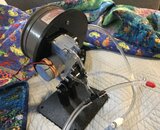Re: Deep Six Signature Diaphragm First Stage
New discovery at the last seminar:
Deep Six Signature has a HP poppet carrier that is removed/reattached/torqued with a 4mm hex key.
To torque it properly, a 3/8" drive hex key works best.
Here's the new tip: do NOT use a ball-end 4mm hex key for the HP poppet carrier! Use a straight shaft/square ended hex key for reassembly and torquing.
The HP poppet carrier's hex broach is also the back end of the balance chamber. In other words, it's only as deep as the thickness of the carrier. A ball-end key has to be positioned exactly at the depth of the broach to avoid shearing off bits of metal from the carrier (ask me how we discovered that!). And you can't place it deeper during torquing, because it hits the poppet shaft beneath it. A ball-end hex key sits naturally at just the wrong depth (the waist of the transition from straight shaft to ball end).
Instead, a straight shaft hex key can be placed at any depth and the hex will engage the flats.
Lesson learned the hard way!
New discovery at the last seminar:
Deep Six Signature has a HP poppet carrier that is removed/reattached/torqued with a 4mm hex key.
To torque it properly, a 3/8" drive hex key works best.
Here's the new tip: do NOT use a ball-end 4mm hex key for the HP poppet carrier! Use a straight shaft/square ended hex key for reassembly and torquing.
The HP poppet carrier's hex broach is also the back end of the balance chamber. In other words, it's only as deep as the thickness of the carrier. A ball-end key has to be positioned exactly at the depth of the broach to avoid shearing off bits of metal from the carrier (ask me how we discovered that!). And you can't place it deeper during torquing, because it hits the poppet shaft beneath it. A ball-end hex key sits naturally at just the wrong depth (the waist of the transition from straight shaft to ball end).
Instead, a straight shaft hex key can be placed at any depth and the hex will engage the flats.
Lesson learned the hard way!







